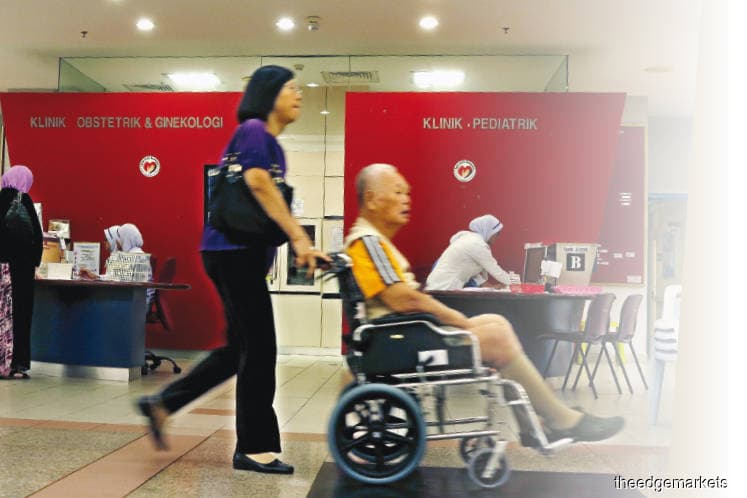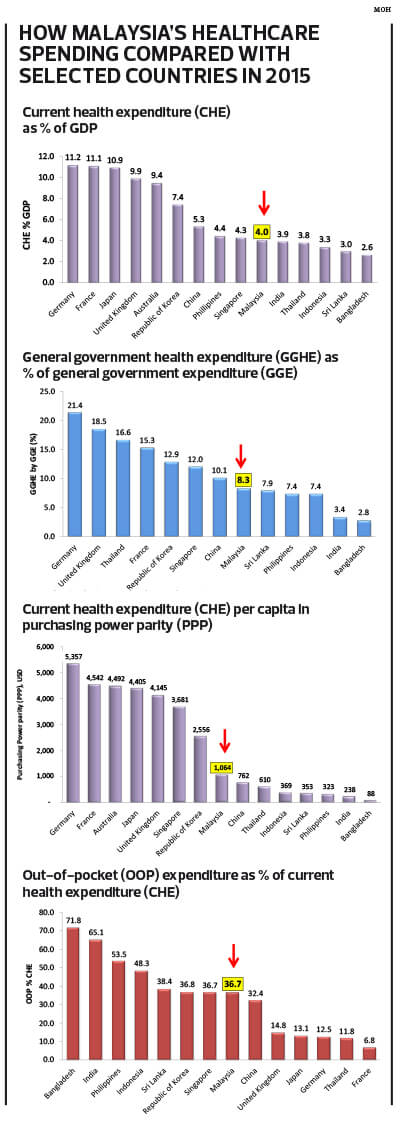
This article first appeared in The Edge Malaysia Weekly on August 13, 2018 - August 19, 2018
LAST Thursday, the Ministry of Health announced that 11 hospitals nationwide would be upgraded to improve access to specialist medical care in the rural areas.
The move is a welcome development for the public health sector, which has been hit by a double blow — the development budget for health has been declining since 2015 and healthcare costs have been rising at double-digit rates.
However, the latest announcement points to a long-standing concern about the paradox that envelops the public healthcare service.
After making great progress in primary healthcare for several decades, Malaysia has failed to make the transition to a responsive health system that addresses the changing health profile of its population and rising expectations for healthcare services.
Among the reports that have spelt this out is one by the Harvard T H Chan School of Public Health commissioned by Malaysia’s health ministry.

The 2016 report notes that the country’s changing demographics, pattern of diseases, sociocultural environment and rising income levels “have contributed to a nutritional transition, increasing health risks and new user expectations”.
Addressing the issue in a speech this month, former director-general of health Tan Sri Dr Mohd Ismail Merican referred to a recent statement by National Diabetes Institute executive chairman Datuk Dr Mustaffa Embong, who revealed that Malaysia has the highest rate of diabetes in Asia and one of the highest in the world, probably next to Saudi Arabia.
Any way the matter is viewed, it opens a Pandora’s box of issues that are plaguing the healthcare sector.
Ismail, who delivered the inaugural speech for the Distinguished Speakers series of the Galen Centre for Health and Social Policy, ran through the gamut of challenges confronting the nation’s health services.
To get a sense of the scale of the problem, it is useful to zoom in on the burden caused by non-communicable diseases like diabetes.
“NCDs or lifestyle diseases like diabetes, hypertension and hyperlipidaemia form about 75% of the disease burden in Malaysia,” says Ismail.
Some 98% of Malaysian adults are at risk of getting at least one lifestyle disease and many face multiple risk factors, health data shows.
Looking at just two aspects of this multidimensional issue illustrates the nature of the challenge the country faces.
One is the grossly inadequate attention paid to the prevention of lifestyle diseases in national policies and programmes. To be fair, the lack of engagement on this issue is seen not just in the health services but throughout the public and private sectors.
Two, in curative treatment, there is a severe imbalance in the distribution of facilities both regionally and between the public and private healthcare providers.
“The relatively lower emphasis placed on preventive medicine compared to curative treatment for NCDs has huge implications for healthcare that need to be addressed,” Galen Centre CEO Azrul Mohd Khalib tells The Edge.
Turning to the availability of specialised health infrastructure, he points out the severe regional imbalance in facilities for cancer treatment and mental health as examples of the maldistribution of resources.
“If you look at where the public health facilities for these diseases are located, the lack of treatment centres outside the west coast of Peninsular Malaysia is extremely stark,” he says (see map on Page 58).
In the light of this situation, the announcement on Thursday that 11 hospitals around the country would be upgraded to the status of minor specialist hospitals could mark the beginning of a new chapter in the healthcare sector.
On the same day, new Minister of Health Dr Dzulkefly Ahmad’s visit to the Kajang Hospital turned the spotlight on the excessive patient load at a number of public health facilities.
Occupancy at the 326-bed hospital is at 150% of its capacity, he said. The ministry plans to build additional blocks and upgrade the existing ones.
While the new government is introducing bold changes to address some of the long-standing shortcomings in the health services, it has a long way to go before unhealthy practices that had set in during the 60-year rule of the Barisan Nasional coalition are jettisoned, say healthcare professionals and advocates of reform.
Areas that require scrutiny include the procurement of supplies, provision of services and contracts for the building of hospitals, Parti Sosialis Malaysia said in a statement last Friday.
“How many of the contracts to buy equipment, food, furniture and so forth are unfairly ‘marked up’ so that certain crony companies can make a quick buck? Please take a good look at this phenomenon that we believe is quite widespread,” said PSM leader Dr Michael Jeyakumar Devaraj.
“Laundry, housekeeping, clinical waste disposal, maintenance of equipment and buildings have all been outsourced since the mid-1990s. The cost of these services went up threefold in 1997, the year after they were outsourced.”
With personal benefit taking precedence over the public good, building simple facilities, providing maintenance and solving patients’ needs do not hold much attraction for some political leaders and administrators, says a past president of the Penang Medical Practitioners’ Society and past chairman of the Penang branch of the Malaysian Medical Association Dr Ong Hean Teik.
In the Penang Hospital, for example, patients due for surgery have had their cases postponed or sent to the Bukit Mertajam Hospital, he tells The Edge.
“The problem is misallocation of funds and poor maintenance,” he says, faulting health officials who want the latest equipment rather than those that are most needed.
Maintenance and facilities are, of course, only part of a range of issues that are crying out for attention.
The shortage of health professionals and trained personnel in relation to the population is another stubborn problem. For the public health sector, staff retention has been a serious challenge.
Azrul of Galen Centre, an independent not-for-profit research and advocacy organisation, refers to the number of cancer specialists to illustrate. Currently, there are 110 oncologists in the government and private sector nationwide, he says.
“This number falls short of the recommended ratio of such specialist doctors to the Malaysian population, which is expected to be an ageing society by 2035. To reach that ratio, the number of oncologists needs to be at least doubled to 240.”
Citing data provided by Malaysian Oncological Society president Dr Matin Mellor Abdullah, Azrul says an ideal ratio of oncologists is 8 to 10 of such specialists per one million citizens. With only 110 oncologists, the current ratio is only about four doctors to one million Malaysians.
A related issue is the imbalance in patient loads between the public and private health sectors.
The public sector has only about 10% of primary care clinics with doctors but handles 60% of outpatient visits, says Ismail, who is currently the pro-chancellor and chairman of MAHSA University, quoting the national health survey data for 2015.
Although there are more hospitals in the private sector, about 76% of hospital beds remain within public facilities. The ratio of hospital admissions in the public and private sectors is 77% to 23%.
The health ministry clearly has its work cut out just to address the cluster of issues relating to staff retention and resource allocation.
“The ministry obviously needs to have a workable solution that covers better pay, recognition of service, career advancement opportunities and better working conditions to stabilise the outflow of professionals from the public healthcare sector,” says Azrul.
An additional area that needs attention is budget shortfalls, which could be alleviated by adopting a multi-year budgeting system, he proposes. This also raises the issue of a sustainable model of healthcare financing that is becoming increasingly urgent.
On this front, a proposal by the new government to roll out a health insurance scheme for the lower-income group earned a sharp rebuke from PSM’s Jeyakumar.
Pointing out that such a scheme would be socially divisive, he was appalled that those in the B40 group may be unable to access critical care when they needed it.
“The richer one-third of Malaysians can get an angiogram done within 24 hours of going to a private hospital while the poorer two-thirds might have to wait for three months just to get to see the cardiologist in the public hospital,” he says.
The idea that participants in the proposed insurance scheme could top up the minimum cover provided by the government if they wanted better coverage was unjust to the poor, Jeyakumar adds.
“Is their health coverage going to be less intensive than that of those who opt to pay more?” he asks.
The government has to consider other ways of meeting the cost of providing healthcare to the population, he says.
A health ministry spokesperson, replying to a request for comments on these and other issues, preferred to wait for a more in-depth discussion at another date.
Save by subscribing to us for your print and/or digital copy.
P/S: The Edge is also available on Apple's AppStore and Androids' Google Play.